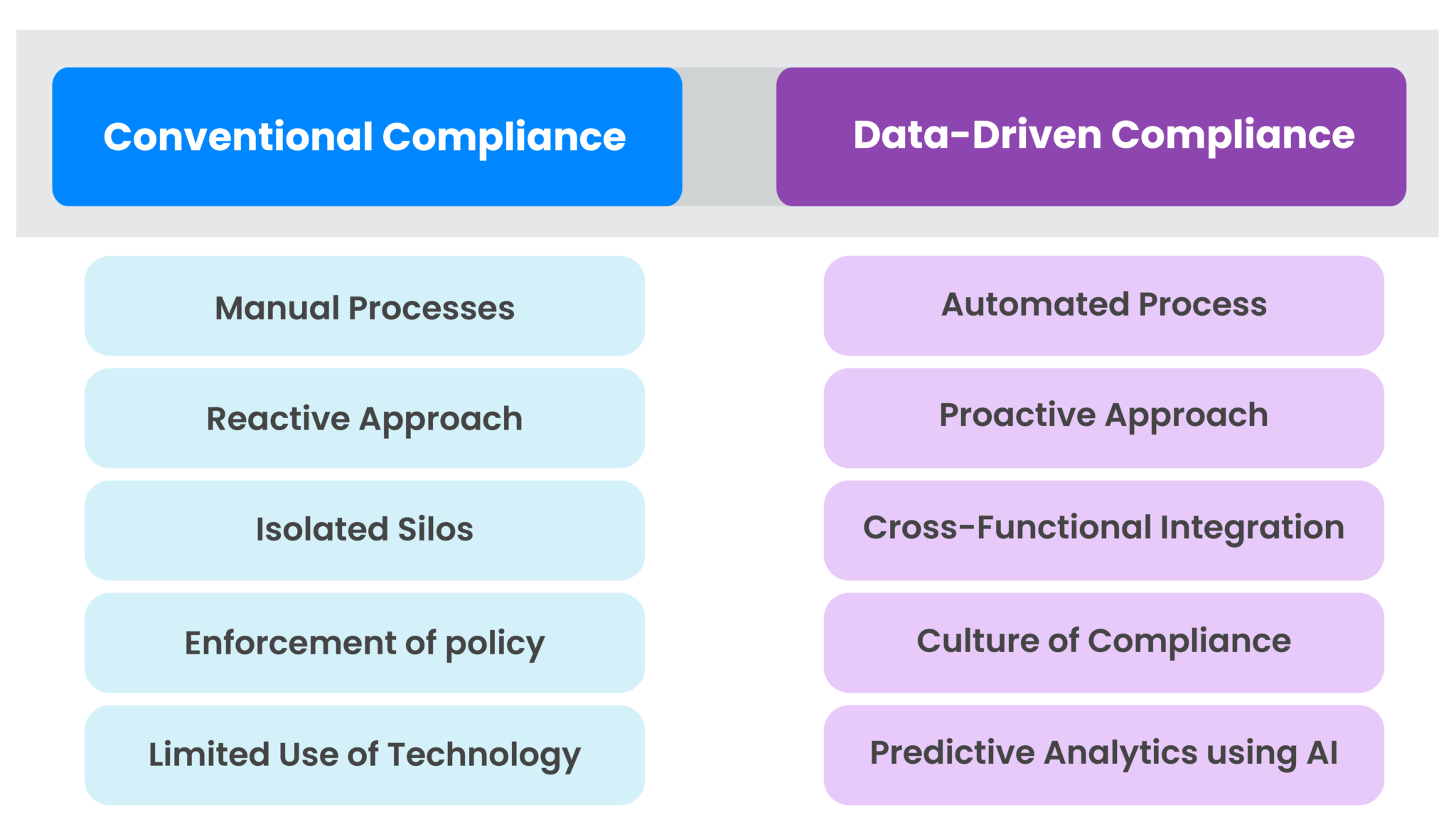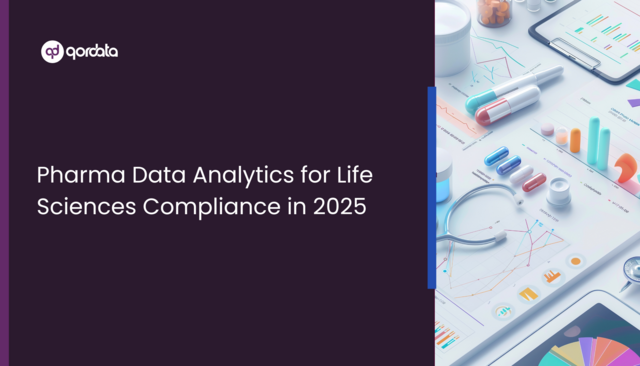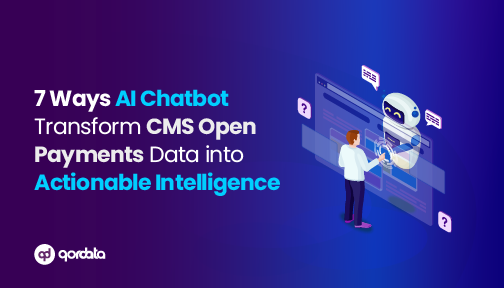The life sciences industry in the United States is a complex and heavily regulated sector. With the critical nature of its work, ensuring compliance with federal and state regulations is paramount.
Life sciences companies dedicate 80% of their resources to making sense of data while realizing only 20% of its value in the form of useful generated insights.
Non-compliance can lead to hefty fines and reputational damage. Data-driven compliance has emerged as a vital strategy to navigate this intricate landscape. By leveraging advanced data analytics, life sciences companies can proactively identify and mitigate compliance risks, fostering a culture of transparency and accountability throughout the HCP engagement process.
Understanding the Challenges Limiting the Effectiveness of a Compliance Program
Firstly, it involves identifying key risks and ensuring they are managed effectively across all functions within the organization. Prioritizing these compliance risks and conducting internal audits provide actionable insights, which demonstrate the value of monitoring and auditing to stakeholders, thereby enabling proactive risk mitigation.
Keeping policies up to date amidst evolving regulations is crucial. This requires fostering cross-departmental consistency within the compliance framework and ensuring that policies are accessible to all employees. Additionally, creating training modules that simplify complex compliance concepts is vital for employees’ understanding of risks. Measuring the overall effectiveness of such programs, though resource-intensive and time-consuming, is necessary to ensure they are effective.
Life sciences companies need to transparently communicate guidelines internally while balancing the need for swift action with due process considerations. Fostering a culture of open communication and trust is another critical aspect, which involves creating a diverse and accessible communication network and setting a top-down tone for ethical conduct and commitment to compliance.
Providing the team with objective, analytical risk assessments is essential to their effectiveness. Lastly, establishing an anonymous reporting system, such as a compliance hotline, and manually conducting timely investigations into violations are necessary. Implementing corrective measures to address root causes and prevent future incidents is imperative for maintaining a robust compliance program.
Conventional Compliance Vs. Data-Driven Compliance
Conventional
- Compliance relies on manual processes for monitoring compliance processes, policies and activities, and reporting. This manual approach can be time-consuming, prone to errors, and less adaptive to regulatory changes.
- Compliance tends to be reactive, addressing issues after they occur or when they are detected during audits. This reactive nature may lead to unnecessary delays, causing risks to escalate to critical levels.
- Different functions operate in silos and manage compliance independently. This lack of integration fosters inefficient compliance efforts and provides stakeholders with a limited view of compliance across the organization.
- Policies are communicated and enforced without effective training. Transparency is limited across the organization and there is a lack of clarity on what’s important for the organization.
- Conventional compliance relies on technologies like spreadsheets and document management systems. The limited use of advanced technologies restricts real-time data analysis and proactive risk management.
Data-Driven Compliance
- Automates routine tasks and processes, reducing manual efforts and minimizing the risk of human error. Automation also ensures efficiency in data collection, analysis, and reporting to the stakeholders.
- Data-driven compliance allows for real-time monitoring of compliance activities to identify control failures. This ensures proactive and timely identification of risks enabling compliance to take preventive measures.
- Data-driven compliance breaks down silos by integrating functions. The holistic approach fosters collaboration, enhances communication, and provides a unified view of compliance efforts.
- Collaboration becomes the key part of training, open communication, self-accountability, and transparency of information across all functions including leadership and contributes to building a culture of compliance.
- Using data analytics and AI, compliance officers can leverage predictive models to forecast potential compliance risks. This enables organizations to implement preventive measures while taking corrective actions.
Let’s delve into how data-driven compliance can be used to address specific challenges within U.S. life sciences commercial compliance:
Aggregate Spend Reporting (CMS Open Payments Reporting)
The Sunshine Act mandates reporting of payments and other transfers of value to HCPs, teaching hospitals and more to the Centers for Medicare and Medicaid Services (CMS). This transparency is crucial for maintaining trust and integrity in the industry. However, managing this reporting process can be complex, especially for large organizations with numerous HCP interactions.
Data-driven compliance solutions can:
- Automated Data Collection: Integrate seamlessly with existing CRM and financial systems to gather data on payments, meals, travel, and other transfers of value.
- Streamline Data Validation and Aggregation: Data cleansing tools ensure data accuracy and consistency across all sources, allowing for efficient aggregation for Open Payments reporting.
- Real-Time Monitoring: Interactive dashboards provide real-time insights into aggregate spend trends and potential reporting issues, enabling proactive adjustments as needed.
- Facilitating Compliance Audits: Complete and accurate data records enable companies to respond quickly and accurately to audit requests from regulatory bodies.
Compliance Monitoring
Continuous monitoring is essential for maintaining compliance in a dynamic regulatory environment. Data-driven compliance enables life sciences companies to:
- Detect and Address Anomalies: Advanced analytics can identify unusual patterns or discrepancies in data, flagging potential compliance issues before they escalate.
- Establish Risk-Based Monitoring: Analyze historical data and identify high-risk HCPs or activities, allowing for targeted monitoring and resource allocation.
- Centralized Data Repository: Consolidate data from various sources into a single platform, facilitating comprehensive trend analysis and anomaly detection.
- Proactive Risk Mitigation: Identify emerging trends that may indicate potential compliance risks, allowing for early intervention and corrective action.
Managing HCP Engagement
Building positive relationships with HCPs is crucial for successful commercialization, but such interactions must comply with the FCA and AKS.
Data-driven compliance solutions can:
- Identify Appropriate Engagement Activities: Analyze data to identify HCPs with relevant expertise and prescribing habits, allowing for targeted and compliant interactions.
- Track Engagement History: Maintain a centralized record of all interactions with HCPs, including meals, travel, and speaker programs, ensuring compliance with frequency and value limits.
- Monitor for Potential Risks: Identify patterns of high-value interactions or frequent contacts with specific HCPs, allowing for proactive risk mitigation strategies.
qordata’s Data-Driven Compliance Platform for Life Sciences
Get a one-window platform that offers comprehensive solutions, training, and services, to ensure compliance programs are both well-designed and effective. Compliance teams can gain a holistic view of organizational risks, covering the seven elements of an effective compliance program while seamlessly integrating with existing processes. qordata utilizes advanced AI technologies, including Computer Vision, OCR, Machine Learning, Data Science, and Generative AI, to address compliance challenges in the life sciences sector.
Benefits of Data-Driven Compliance
Data-driven compliance offers many benefits for U.S. life sciences companies, fostering a more efficient and effective approach to navigating the regulatory landscape. Here are some key advantages:
- Reduced Risk of Non-Compliance: Proactive risk identification and real-time monitoring minimize the chances of non-compliance issues, protecting companies from penalties and reputational damage.
- Enhanced Operational Efficiency: Automating routine tasks and streamlining data management free up valuable resources, allowing teams to focus on strategic initiatives and core business activities.
- Improved Audit Readiness: Centralized data and automated reports ensure compliance teams are prepared for audits with easily accessible and accurate documentation.
- Data-Driven Training and Development: By analyzing compliance data, companies can identify areas where employee training is needed, leading to a more knowledgeable and compliant workforce.
- Cost Savings: Improved efficiency, reduced errors, and fewer violations lead to significant cost savings eventually.
- Enhanced Decision-Making: Data-driven insights support informed decision-making, enabling companies to proactively address compliance challenges.
- Greater Transparency: Comprehensive data records foster transparency and accountability, strengthening stakeholder trust.
Conclusion
Navigating the complex world of U.S. commercial compliance can be challenging. By embracing data-driven compliance, life sciences companies can achieve a more efficient, effective, proactive, and risk-mitigated approach to compliance.
Other Relevant Reads:






